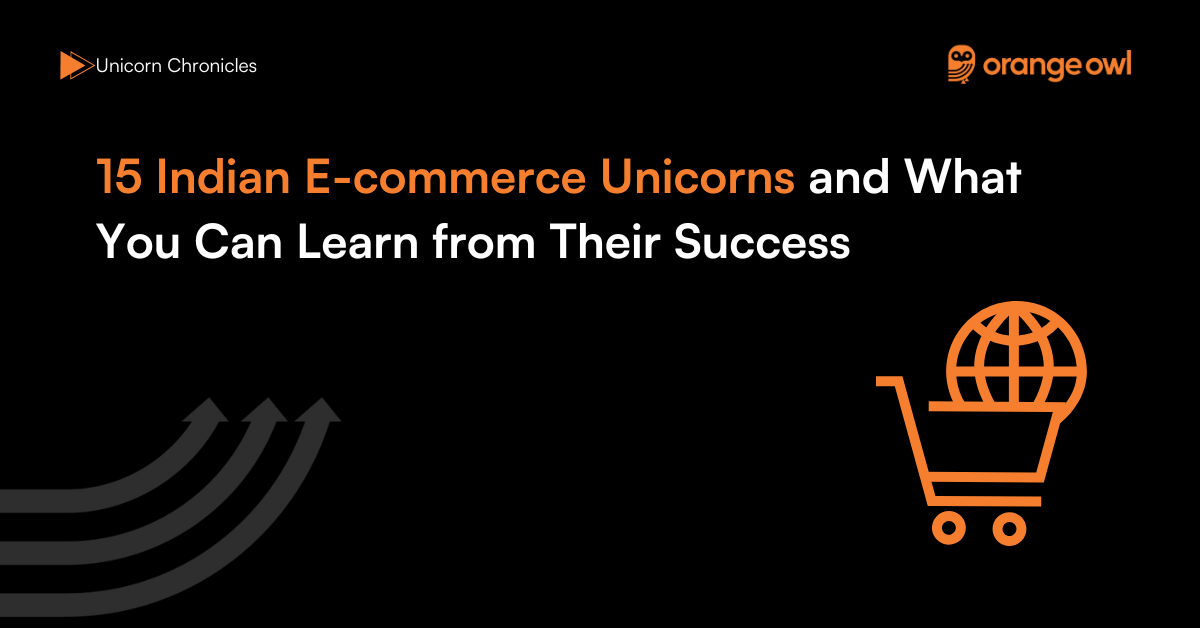15 Indian E-commerce Unicorns and What You Can Learn from Their Success
Vivek Goel
May 26, 2025

Table of Contents
Introduction
India’s e-commerce revolution has transformed the country into one of the fastest-growing digital retail markets in the world. Valued at over $100 billion in 2023 and projected to reach around $200 billion by 2030, the sector is growing at an impressive CAGR of over 25% annually. This explosive growth is driven by increasing internet penetration, rising smartphone adoption, and a rapidly expanding digital payment ecosystem. Moreover, the rise of regional language content and vernacular platforms has enabled startups to penetrate deep into Tier 2 and Tier 3 cities, unlocking vast untapped consumer bases.
Within this booming landscape, a powerful cohort of Indian e-commerce unicorns—startups valued at over $1 billion—has emerged. These companies are not just scaling fast but rewriting the rules of online retail through innovation tailored to India’s unique consumer behaviors and preferences. They span diverse verticals, from hyperlocal grocery delivery and healthcare to baby products and beauty, reflecting India’s multifaceted market needs.
Their success stories highlight how affordability, trust-building, technology integration, and a sharp focus on underserved segments can create disruptive business models that rapidly gain customer loyalty. These unicorns exemplify how hyperlocal approaches, seamless omnichannel experiences, and tech-enabled supply chain efficiencies have become critical levers in capturing India’s vast and varied consumer market.
By studying the journeys and strategies of these Indian e-commerce leaders, entrepreneurs can gain invaluable insights into navigating emerging markets, scaling with customer-centric innovation, and driving sustained growth in a complex, evolving environment.
1. DealShare: Democratizing E-commerce for Bharat
DealShare disrupted Tier 2 and Tier 3 markets by focusing on affordability, social buying, and regional language accessibility. With a vision to serve Bharat—the real India beyond metros—DealShare created a community-centric model that enabled group buying, allowing customers to get better deals by sharing them with friends and family. This not only helped reduce customer acquisition costs but also built strong local brand loyalty. Their regional language interface and focus on local products made them highly relatable to their audience. Their community-focused approach helped them scale rapidly in underserved markets, proving that e-commerce isn’t just for the elite urban crowd.
Key Lessons:
- Focus on underserved demographics with tailored solutions.
- Leverage regional language and local product strategies.
- Use virality through social commerce.
- Prioritize affordability without compromising quality.
2. PharmEasy: Transforming Healthcare Access
PharmEasy bridged the gap between patients and healthcare providers by building a seamless medicine delivery and diagnostics ecosystem. By digitizing prescriptions, offering doorstep deliveries, and ensuring authenticity of medicines, PharmEasy made healthcare more accessible and convenient. Their acquisitions, such as Medlife and Thyrocare, further cemented their presence across the healthcare value chain. With a tech-first approach and an unwavering focus on compliance and safety, PharmEasy became a go-to solution for millions across India.
Key Lessons:
- Solve real problems with tech-first solutions.
- Build strategic partnerships to scale healthcare services.
- Prioritize trust and data transparency.
- Expand into adjacent categories like diagnostics and wellness.
3. Meesho: Empowering India’s Micro-entrepreneurs
Meesho enabled millions to become online sellers without inventory, targeting women in small towns and rural India with a zero-cost reselling model. By focusing on social commerce, Meesho turned WhatsApp and Facebook users into digital entrepreneurs, creating a ripple effect of empowerment. The platform’s ease of use, vernacular language support, and zero capital requirements made it immensely popular among first-time internet users. With smart logistics and secure payments, Meesho ensured that even the smallest entrepreneur could succeed.
Key Lessons:
- Empower users to create income-generating opportunities.
- Keep entry barriers extremely low.
- Build a mobile-first, vernacular-friendly platform.
- Focus on logistics and trust to enable micro-commerce.
4. FirstCry: Winning the Parenting Market
FirstCry became a household name for parents by offering curated products for babies and kids, supported by both online and offline channels. The brand understood the emotional and practical needs of new parents and built trust through specialized offerings. With over 400 physical stores, FirstCry blended the convenience of e-commerce with the reassurance of physical presence. Their partnerships with hospitals ensured early brand engagement, making FirstCry a default choice for new parents.
Key Lessons:
- Serve a focused niche with personalized offerings.
- Blend online convenience with offline experience.
- Build brand trust in sensitive markets (like baby care).
- Partner with hospitals and maternity centers for early access.
5. Infra.Market: Redefining B2B Construction Supply
Infra.Market digitized the fragmented construction industry by providing quality-assured materials and analytics to builders and contractors. Tackling inefficiencies in procurement, they streamlined supply chains and standardized product quality in a sector notorious for delays and inconsistencies. Their tech platform enabled real-time tracking, dynamic pricing, and bulk order efficiencies. Infra.Market’s global expansion and vertical integration showcase how B2B commerce in legacy sectors can be modernized with the right tools.
Key Lessons:
- Digitize traditional industries to unlock value.
- Maintain product standardization in unorganized sectors.
- Use technology for logistics and inventory management.
- Expand aggressively into exports and new verticals.
6. BigBasket: Leading the Online Grocery Race
BigBasket’s early entry and obsession with supply chain innovation helped it build a stronghold in online groceries across Indian metros. By focusing on fresh produce, consistent delivery, and private-label brands, BigBasket became synonymous with convenience in grocery shopping. The company’s backend operations—from warehouses to last-mile delivery—were finely tuned for efficiency. They also adapted swiftly during the pandemic, reinforcing their position as an essential service provider.
Key Lessons:
- Win in low-margin sectors with operational excellence.
- Invest in private labels to improve profitability.
- Use tech to optimize the supply chain.
- Focus on repeat purchases and customer retention.
7. Udaan: Empowering India’s Retailers
Udaan created a B2B platform to streamline procurement for small retailers, offering everything from logistics to working capital. The platform bridged the gap between manufacturers and retailers in Tier 2 and 3 cities, helping shop owners get better prices and faster delivery. Udaan’s fintech integration allowed credit facilities for small businesses, solving one of their biggest pain points. Its horizontal marketplace model made it a preferred partner for millions of retailers.
Key Lessons:
- Solve distribution challenges for small businesses.
- Offer embedded fintech services like credit.
- Build deep logistics networks for underserved regions.
- Trust in horizontal B2B platforms for scale.
8. Paytm Mall: Converging Online and Offline
Leveraging Paytm’s digital payments ecosystem, Paytm Mall integrated offline retailers into its online platform to create an omnichannel retail experience. The goal was to empower local kirana stores and traditional retailers by offering them a digital storefront. Through QR codes, local offers, and seamless payment options, Paytm Mall built a hybrid model that aimed to merge convenience with familiarity. Cashback schemes and loyalty programs boosted user stickiness, making it a strong contender in the retail tech space.
Key Lessons:
- Leverage existing ecosystems for fast adoption.
- Integrate offline and online seamlessly.
- Use cashback and loyalty programs for user retention.
- Collaborate with local sellers instead of competing.
9. ShopClues: Pioneering Value Commerce
ShopClues carved a niche in the Indian e-commerce landscape by catering to the vast base of price-sensitive consumers in Tier 2 and Tier 3 cities. It focused on offering unbranded, affordable products that resonated with the everyday needs of middle-income buyers. Rather than competing with high-end marketplaces, ShopClues tapped into the “value-for-money” sentiment prevalent in small-town India. Its strategy revolved around keeping operational costs low, building a mass-market brand appeal, and curating a marketplace that provided functional products at bargain prices.
Key Lessons:
- Target price-sensitive customers with value-driven offers.
- Optimize cost structures to survive thin margins.
- Focus on mass-market appeal over premium positioning.
- Build trust in non-branded product categories.
10. Snapdeal: Reinventing Through Value
Snapdeal, once a strong contender in India’s e-commerce race, faced major setbacks due to fierce competition and misaligned growth strategies. However, instead of bowing out, it executed a bold pivot, repositioning itself as a value-commerce platform. By realigning its business to serve the needs of budget-conscious customers, Snapdeal made a strategic comeback. Its renewed focus was on sustainable profitability, clear differentiation, and targeting underserved market segments where price was the primary factor in purchase decisions.
Key Lessons:
- Pivot boldly when facing saturation or failure.
- Define a unique value proposition clearly.
- Serve India’s “middle” economy with the right mix.
- Prioritize profitability over growth at any cost.
11. Flipkart: The Pioneer of Indian E-commerce
Flipkart set the blueprint for India’s e-commerce industry by addressing localized consumer behavior and solving logistical challenges early on. Its innovative approach included offering cash-on-delivery, robust return policies, and building Ekart, its in-house logistics arm, to manage last-mile delivery across the country. Flipkart’s ability to anticipate and adapt to market trends—whether through launching new verticals or pioneering festive sale events—cemented its position as a category-defining brand in India’s digital retail story.
Key Lessons:
- Innovate based on local market dynamics.
- Build end-to-end infrastructure (logistics, payments).
- Offer customer-centric policies like easy returns.
- Stay ahead by launching new verticals proactively.
12. Purplle: The Digital Beauty Destination
Purplle rose through India’s highly competitive beauty segment by focusing on affordability and accessibility. By targeting value-conscious middle-class consumers, it positioned itself as a go-to destination for budget beauty needs. Its strength lies in a data-backed approach to personalization, launching private labels for better margins, and building trust through authentic user reviews and influencer collaborations. With a strong digital-first strategy, Purplle successfully built a differentiated identity in a space dominated by premium international brands.
Key Lessons:
- Make beauty accessible through pricing and education.
- Invest in influencer-driven content and reviews.
- Launch private labels for higher margins.
- Customize offerings using AI-based recommendations.
13. Blinkit: Speed is the New Retail
Blinkit, formerly Grofers, revolutionized quick commerce in India by pioneering the 10-minute delivery promise. The company leaned into consumer demand for instant gratification, creating a network of hyperlocal dark stores to fulfill grocery and daily needs faster than ever. Its rebranding to Blinkit was more than cosmetic—it symbolized a focused shift to speed-first retail. With high-frequency purchases and operational innovation, Blinkit became a standout player in the emerging quick-commerce segment.
Key Lessons:
- Identify and deliver on unmet consumer desires (speed).
- Build operationally lean dark store networks.
- Focus on high-frequency use cases.
- Rebrand decisively to reflect evolution.
14. Nykaa: Beauty with Omnichannel Power
Nykaa disrupted the beauty and personal care space by combining e-commerce with deep content and influencer strategies. Targeting women across urban and semi-urban India, it brought a mix of international brands and affordable local options. Nykaa’s strength was its ability to educate users via tutorials, reviews, and expert content, building trust over time. With the launch of offline stores and private labels, the company scaled an omnichannel model while maintaining profitability and brand loyalty.
Key Lessons:
- Blend content and commerce to build trust.
- Target a specific demographic with curated offerings.
- Expand omnichannel with profitable stores.
- Scale D2C brands using platform data.
15. Lenskart: Vision at Scale
Lenskart revolutionized the eyewear market in India by creating an end-to-end supply chain—from manufacturing to direct-to-consumer distribution. By integrating online tools like 3D virtual try-ons and home eye check-ups with a growing network of offline experience stores, Lenskart made quality eyewear affordable and accessible. The company leveraged technology not just for convenience but to build trust and consistency across its product and service delivery, scaling rapidly both in India and abroad.
Key Lessons:
- Control the supply chain for better margins.
- Use AR and home trials to drive online adoption.
- Expand with experience-focused offline stores.
- Build trust with consistent quality and service.
Conclusion
Each of these remarkable e-commerce unicorns represents a compelling story of how deep market understanding, unwavering consumer focus, and relentless innovation come together to create lasting success. They demonstrate that thriving in India’s dynamic and diverse marketplace requires more than just a good product—it demands continuous adaptation to shifting consumer behaviors, smart leveraging of technology, and building trust across all customer touchpoints.
Whether you are an entrepreneur launching a direct-to-consumer (D2C) beauty brand, developing a B2B procurement platform, or scaling a hyperlocal delivery service, the lessons drawn from India’s e-commerce unicorns are invaluable. These companies show that prioritizing affordability without sacrificing quality, empowering underserved segments, integrating offline and online experiences, and investing in operational excellence are not just theories—they are proven strategies that drive growth and sustainability.
Moreover, these success stories emphasize the importance of building scalable supply chains, adopting vernacular and mobile-first approaches, and fostering communities that turn customers into brand advocates. By embracing these principles, entrepreneurs can unlock new opportunities and navigate the challenges of India’s fast-evolving e-commerce ecosystem.
In essence, the journeys of these unicorns offer more than inspiration—they provide actionable blueprints for innovation and resilience that any entrepreneur can adapt to their own venture, regardless of industry or scale. Learning from their successes and setbacks equips emerging businesses to compete confidently and build brands that resonate deeply with the modern Indian consumer.
Explore the complete Unicorn Chronicles series on Orange Owl Marketing to dive deeper into each story.


